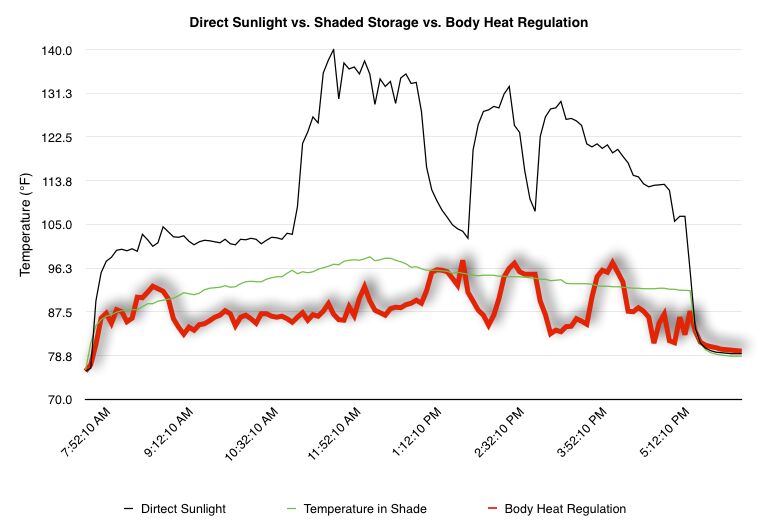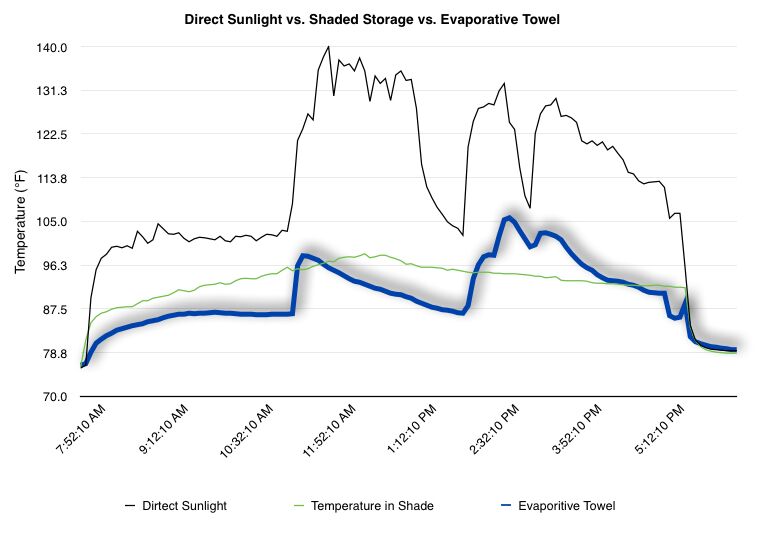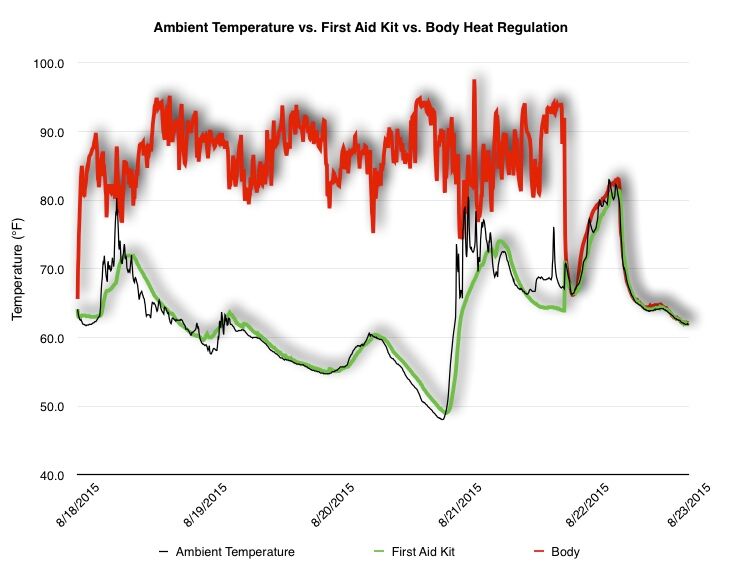As travelers, we routinely find ourselves in locations with a wide range of temperatures, many of which are outside of the medication storage range of 59 to 86 degrees suggested by the United States Pharmacopoea.* Epinephrine, a medication of specific interest to individuals with a history of severe allergic reactions and those with medical responsibilities in remote environments, has a similarly narrow storage range. Per the manufacturer of EpiPen, storage should be between “68℉ to 77℉ with excursions permitted to 59℉ to 86℉.”**
Some research is available about medication kept outside of recommended temperature storage. This includes a study of the effectiveness of epinephrine after multiple freeze-thaw cycles.*** Several studies have been completed on the effect of warm environments on medication and show degradation after exposure to high temperatures.
The medical market has few tools designed to manage medication temperature in remote environments that are also functional to carry while on an outing or expedition. The devices that are non-powered and low-tech are for insulin storage, and use refrigerated chemical cooling packs that provide several hours of temperature stability. One exception is the Frio Insulin Cooling Case which uses evaporative cooling to keep medication cool in warm environments. While the insulin storage devices do work to keep medications cool, they do not address the issue of storage in cold environments.
Testing
This year, Longleaf Wilderness Medicine completed a broad study of medication storage options in a variety of environments and activities. The hypothesis of the study was that storage near the body would provide a relatively stable temperature. The desired outcome of the testing was to be able to suggest a low-tech and low-cost storage option for travelers to maintain medication temperature stability.
LogTag data loggers were used to conduct the tests. Test duration and logging intervals depended on the specific environment and activity. Each test included specific loggers that recorded the ambient temperature of the environment, as well as the temperature inside a first aid kit and at the base layer of clothing of a test subject. Several other storage options were also assessed during test depending on environment.
Test #1
Location: Mobile-Tensaw River Delta, Alabama
Season: Winter
Activity: Canoeing
Length of Assessment: 5 days
Interval: 20 Minutes
Logger Locations: Ambient temperature, on body, insulated and inside jacket pocket, first aid kit, and inside a thermos.

Data from loggers stored at a tester’s base layer and in a jacket pocket showed a large variation. The logger stored at the base layer showed several short drops and, based on time of day they were recorded at, were likely associated with clothing changes. The logger stored in a pocket was wrapped in a small fleece towel and placed in a plastic bag. The result was a cooler and more varied temperatures likely based on subject behavior (i.e., clothing changes, layer changes, changing storage pocket, etc.).

Direct body heat logger worn as a necklace and under insulating layers.

Insulated logger being placed in a pocket. The pocket used for storage changed during the test depending on what layers were being worn.
A Zojirushi insulated vacuum thermos was used to assess an alternative insulation option. The thermos was brought into the tester’s sleeping bag each night resulting in a temperature rise each evening.

Test #2
Location: Selkirk Mountains, Idaho
Season: Winter
Activity: SAR survival training, activities included hiking with a full pack and building emergency shelters.
Length of Test: 24 hours
Interval: 20 minute
Logger Locations: Ambient temperature, first aid kit, and on body, near a chemical heat pack within a simulated first aid kit.


Test #3
Location: Grand Bay, MS
Season: Summer
Activity: Wilderness First Aid course
Length of Assessment: 10 Hours
Interval: 5 minutes
Logger locations: Direct sun, shade, on body, and within an evaporative towel
During the hot weather test, body heat storage was measured by a temperature logger worn around the patient’s next in the same manner as cold weather tests. The two noticeable drops in temperature were due to the tester moving from outside to inside, where the classroom temperature was controlled by air conditioning. The evaporative cooling towel provided a similar storage condition as the Frio insulin cooling device mentioned above. The towel was soaked in water and placed in the sun. Warming spikes in temperature are noted in the chart when the towel became dry. Cooling after the spikes was facilitated by dipping the towel in tepid water.



Test #4
Location: Isle Royale National Park, MI
Season: Fall
Activity: Backpacking
Test Length: 4 days
Interval: 15 minutes
Logger Locations: Ambient temperature, on body, and first aid kit

Discussion
The testing shows several low-tech ways to work toward maintaining a 59-86 ℉ storage range. Although slightly warmer than recommendation, regulation with body heat proved an effective solution for cold weather trips. In mild temperatures as experienced during the Isle Royale trip, the best storage location, per the data, was the first aid kit. However, this would not be a truly reliable option due to the potential of acute change in weather. In hot environments, on-person storage resulted in relatively stable temperatures both in sun and shade. The cooling towel also proved effective, however the data shows a potential issue if the evaporative material gets too dry, making the towel a higher maintenance option. Overall, testing demonstrated that body heat provided the most consistent temperature through the range of environments tested and should be considered as a storage option for sensitive medications in a wide range of temperatures.
There are a number of products currently on the market (e.g., WaistPal) that are designed specifically for the storage of epinephrine, allowing ease of medication accessibility while the carrier is recreating. While the goal of the devices is not temperature management, based on the data of this study, they would provide a stable temperature.
If one is carrying multiple medications, one solution is to place medication in a small, soft-sided organizer bag and then into an avalanche beacon harness. While space is limited, an avalanche beacon harness offers a high level of comfort and does not impact the ability to also wear a backpack. As the temperature rises, the same organizer and harness storage technique can be used; however, in very high temperatures a more comfortable alternative would be to wrap the organizer in an evaporative towel and secured to the outside of a pack using a daisy chain or tactical MOLLE system.
The informal study described is intended to be a starting point for insight to the temperatures experienced by medications in remote environments and to find solutions for managing temperatures in temperatures outside of pharmaceutical recommendations. Further study in more extreme climates is warranted regarding storage in those environments. Regardless of where medication is carried on an expedition, it is most important to have a system that allows medication to be accessed quickly by those who use it.
Sources:
*Madden, J.F., et. al., (1999) The range of medication storage temperatures in aeromedical emergency medical services. Prehosp Emerg Care. 3(1). 27-30.
** Wolf, Ray A. (2014). Regarding the Use of Epinephrine Auto-injectors in Remote Settings.
Wilderness & Environmental Medicine, 25 (4), 490.
***Beasley, Heather, et.al., (2015). The Impact of Freeze-Thaw Cycles on Epinephrine. Wilderness & Environmental Medicine, 26(1). 94
Posted on November 29, 2015